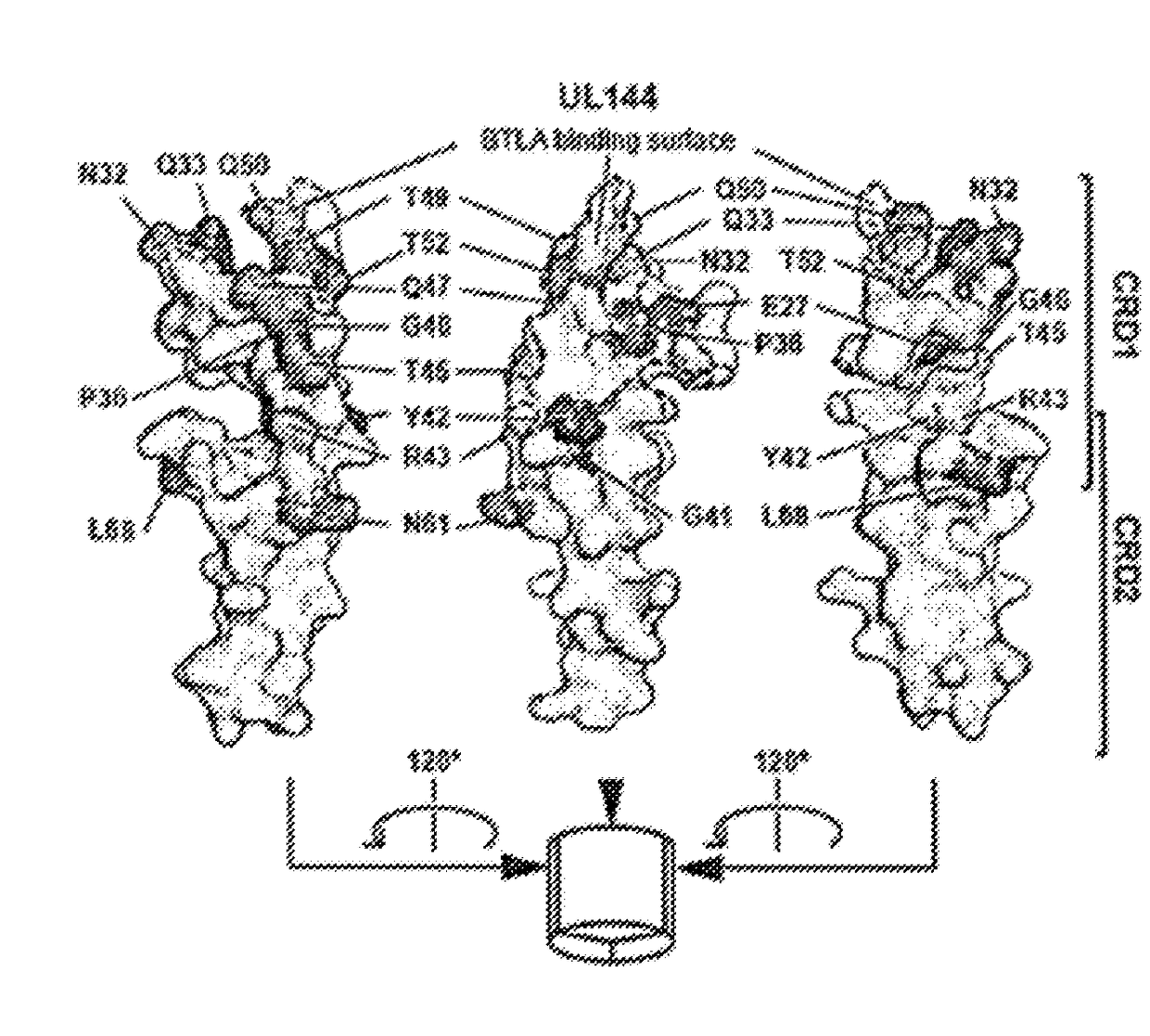Btla fusion protein agonists and uses thereof
a technology of fusion proteins and agonists, applied in the field of fusion proteins, can solve the problems of largely failure of attempts to develop antibody-based therapies designed to activate human inhibitory receptors, and achieve the effect of increasing btla signaling
- Summary
- Abstract
- Description
- Claims
- Application Information
AI Technical Summary
Benefits of technology
Problems solved by technology
Method used
Image
Examples
example 1
UL144 Residues Homologous to HVEM are Required for Binding to BTLA
[0083]Human CMV encoded UL144 selectively binds BTLA but not CD160 and inhibits T cell proliferation activated by T cell receptor signaling to a greater extent than HVEM proteins. To determine whether the selection for BTLA by UL144 resulted from unique interactions between the surfaces of these two proteins the structure of the BTLA contact surface of UL144 was modeled on the previously solved HVEM-BTLA co-crystal (FIG. 1A). Next, the UL144 surface residues that were divergent from HVEM by alanine- and homology-scanning mutagenesis to screen potential BTLA binding surfaces were targeted (FIG. 1). It was observed mutation in several UL144 residues disrupted or reduced binding of BTLA that define a surface centered on one face of the CRD1 region similar to the BTLA binding surface of HVEM. The most critical mutations validated to be surface expressed occur at Gly41 and Tyr42, homologous to Gly60 and Tyr61 in HVEM (FIG....
example 2
Somatic TNFRSF14 Mutations in Lymphoma Target Ligand Binding
[0091]It was noted that somatic TNFRSF14 mutations acquired in FL and DLBCL have the potential to interrupt conserved HVEM interactions with its ligands, and subsequent function (FIG. 8). Lymphoma-associated mutations were selected that were not predicted to disrupt the HVEM structure and assessed mutant receptor binding to BTLA, CD160, and LIGHT. HVEM mutants validated to be surface expressed could be categorized into three groups according to their effects on ligand binding (FIG. 8). Mutations containing P59S, A102P, or R109W disrupted interactions with CD160 alone. Y61C and G72D mutations abrogated interactions with both BTLA and CD160, but did not greatly affect LIGHT binding. Finally, mutants G60D and T82P, or an insertion of Ile between Ser91 and Lys92 disrupted all ligand interactions (FIG. 2). HVEM Tyr61 has been identified as critical for binding both BTLA and CD160. Together, these somatic mutations define a hiera...
example 3
HVEM and UL144 Bind Overlapping Surfaces of BTLA
[0092]To determine whether altered BTLA activity by viral UL144 or mutant HVEM was due to engagement of different surfaces, BTLA residues in contact surfaces for these agonists were compared. It was found that binding of the anti-BTLA mAb (clone MIH26) previously shown to have agonistic activity was disrupted by mutation at either Glu57 or Pro59, while binding of the competitive anti-BTLA mAb (clone J168) was disrupted by mutation at Arg42 (FIG. 3A and FIG. 9A). Notably, the M1H26-binding residue Glu57 is homologous to Gln63 in mouse BTLA, which is contained within the epitope of the agonistic anti-BTLA mAb (clone 6A6). In comparison, similar requirements were observed for binding of both HVEM-Fc and UL144-Fc to Gln37, Arg42, Pro59 and His127, consistent with previous studies in human and mouse BTLA. Similar affinities for BTLA to HVEM or UL144 were confirmed using surface plasmon resonance (FIG. 3B, C). The avidity (KD, 1:1 binding mo...
PUM
| Property | Measurement | Unit |
|---|---|---|
| Weight | aaaaa | aaaaa |
| Immunogenicity | aaaaa | aaaaa |
| Chemotherapeutic properties | aaaaa | aaaaa |
Abstract
Description
Claims
Application Information
 Login to View More
Login to View More - R&D
- Intellectual Property
- Life Sciences
- Materials
- Tech Scout
- Unparalleled Data Quality
- Higher Quality Content
- 60% Fewer Hallucinations
Browse by: Latest US Patents, China's latest patents, Technical Efficacy Thesaurus, Application Domain, Technology Topic, Popular Technical Reports.
© 2025 PatSnap. All rights reserved.Legal|Privacy policy|Modern Slavery Act Transparency Statement|Sitemap|About US| Contact US: help@patsnap.com



